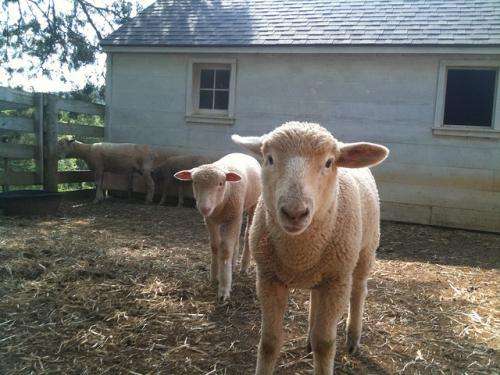Link between falling hormone and early puberty in sheep

New information about the relationship between hormones, muscle development and puberty onset could help farmers efficiently breed sheep for meat.
A new study links accumulation of muscle and intramuscular fat—or the marbling of meat—to earlier puberty in lambs.
UWA Animal Science Professor Graeme Martin says the finding suggests farmers can genetically select their animals for faster production of lean meat, and at the same time advance puberty, improve flock efficiency and reduce their greenhouse gas footprint.
"Having the lambs go through puberty earlier, and being fertile earlier is a really important driver in productivity of the system," he says.
He says body fat has long been thought to be the major factor controlling puberty, however, this is a problem for farmers when consumers want to avoid fatty meat.
"Now we can see that muscle is also involved in sending signals to the brain about the maturity of the body," Prof Martin says.
"It looks like the signal from muscle might be [the hormone] follistatin."
Researchers also found that intramuscular fat produces the hormone leptin, known to control puberty.
"Leptin comes from fat cells not muscle cells…we have dismissed [muscle] in the past as a source of leptin."
Prof Martin says the two hormones could be involved in telling the brain there's enough muscle tissue in metabolic reserve to sustain pregnancy and lactation.
"It looks like follistatin concentrations have to go down in the blood, which will tell the brain the muscle has stopped growing, before it says 'that's enough muscle, now we can reproduce.'"
Follistatin inhibits reproduction
Researchers drew their conclusions from two studies involving hundreds of young Merino ewes on farms, weighing them bi-weekly to calculate average daily weight gain and to estimate their weights at puberty and conception.
They also used ultrasound to measure depth of the longissimus dorsi muscle and subcutaneous fat on the twelfth rib, and took regular blood samples from the lambs to measure follistatin and leptin concentrations.
As muscle accumulated, leptin concentration increased, but follistatin levels decreased.
"It looks as though follistatin inhibits reproduction, so the fall in its concentration is necessary for puberty to proceed."
Prof Martin says more needs to be understood about how follistatin affects the body, but the study provides a very clear message to industry about muscle development.
"Acceleration of muscle development by genetic selection will also advance puberty," he says.
"That's something that industry can use right now."
More information: C.A. Rosales Nieto, A.N. Thompson, C.A. Macleay, J.R. Briegel, M.P. Hedger, M.B. Ferguson, G.B. Martin, "Relationships among body composition, circulating concentrations of leptin and follistatin, and the onset of puberty and fertility in young female sheep," Animal Reproduction Science, Volume 151, Issues 3–4, 30 December 2014, Pages 148-156, ISSN 0378-4320, dx.doi.org/10.1016/j.anireprosci.2014.10.008.
Provided by Science Network WA


















